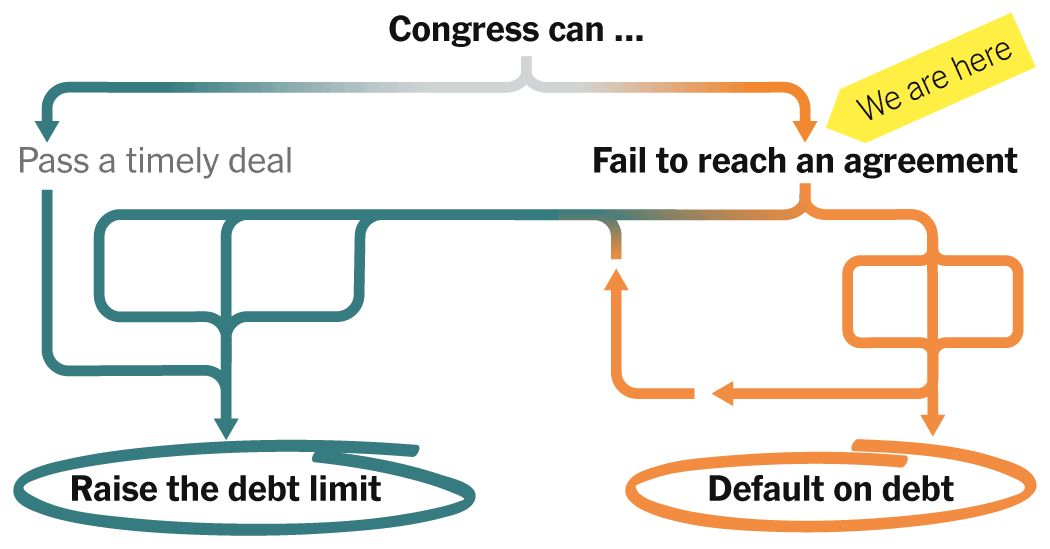The Road to Raising the Debt Limit
Time is running out for Congress to raise the nation’s debt limit, which controls how much money the government can borrow to pay its bills. Lawmakers will need to reach a bipartisan agreement to lift the cap. The longer it takes, the more turmoil there could be for the United States and the global economy.
Congress can ... We are here Pass a timely deal Fail to reach a timely agreement Use congressional maneuvers Let X-date pass Treasury decides which payments to default on Default on debt Raise the debt limit Congress can ... We are here Pass a timely deal Fail to reach an agreement Use congressional maneuvers Let X-date pass Treasury decides which payments to default on Raise the debt limit Default on debt
Since the United States reached its debt limit in January, the Treasury Department has been using accounting tricks — known as “extraordinary measures” — to continue paying America’s bills and avoid default. Janet L. Yellen, the Treasury secretary, said that the nation would exhaust these measures by June 1, hitting what is known as the “X-date.”
There are several potential paths to raising the debt limit. Some are straightforward but unlikely, while others are more challenging or could cause economic chaos.
Timely, but unlikely
Congress can ... Pass a timely deal Fail to reach an agreement Raise the debt limit Default on debt Congress can ... Pass a timely deal Fail to reach an agreement Raise the debt limit Default on debt
The simplest resolution would be to cleanly pass an agreement to raise or suspend the debt limit before the United States runs out of cash. The debt limit was raised this way three times during the Trump administration and dozens of times during past presidencies.
But House Republicans have made clear that they want stipulations in the form of spending cuts attached to this next debt limit increase. The Biden administration has dug in on the other side, insisting that it will only accept an agreement without spending cuts. President Biden will meet with top Republicans and Democrats at the White House on Tuesday to discuss a path forward.
If House Republicans agree to the White House’s no-strings-attached stance, or if the White House agrees to some spending cuts, a deal could be struck without severe market disruptions or special congressional maneuvers. Given where both sides stand now, that seems unlikely.
Before the X-date
Without a timely deal, markets could be in for a wild ride as the nation stares down a period of brinkmanship.
Congress can ... Pass a timely deal Fail to reach an agreement Potential market volatility Temporary suspension Delay the debate Raise the debt limit Default on debt Congress can ... Pass a timely deal Fail to reach an agreement Potential market volatility Temporary suspension Delay the debate Raise the debt limit Default on debt
Republicans have floated the idea of a temporary suspension, which would mean delaying the debt limit debate until a later date. In the meantime, Congress would agree to raise the limit by a small amount that would buy a little more time. Such a move would essentially kick the can down the road.
The catch: While Wall Street analysts have suggested that the impending X-date increases the chance of a temporary suspension, so far there appears to be little appetite in Congress for a delay that both sides could accept. The debate would still need to happen, and if delayed long enough, it might collide with the 2024 presidential election cycle, presenting a political wild card at an inopportune time.
Congress can ... Pass a timely deal Fail to reach an agreement Potential market volatility Discharge petition House majority, regardless of party Default on debt Raise the debt limit Congress can ... Pass a timely deal Fail to reach an agreement Potential market volatility Discharge petition House majority, regardless of party Raise the debt limit Default on debt
Congress could also use a special maneuver called a discharge petition to skirt conservative Republican holdouts and try to squeak an agreement through the House. A discharge petition is a demand with signatures from a majority of the House members, regardless of party affiliation, that can force a piece of legislation — like a bill to raise the debt limit — to be considered on the House floor. Such a measure could be used either before or after the X-date.
The catch: Discharge petitions are time-consuming and easily derailed. The process requires at least five House Republicans to go on the record with their signatures to circumvent Speaker Kevin McCarthy and party leadership. In a sign of growing concern about the debt limit, Democrats recently began the discharge petition process and plan to start collecting signatures in mid-May.
Congress can ... Pass a timely deal Fail to reach an agreement Potential market volatility Last-minute deal Spurred by market volatility Raise the debt limit Default on debt Congress can ... Pass a timely deal Fail to reach an agreement Potential market volatility Last-minute deal Spurred by market volatility Raise the debt limit Default on debt
In 2011, lawmakers allowed the debt limit debate to get down to the wire, and then agreed to raise the debt limit at the last minute. Politicians have suggested in private that it could take severe turmoil in financial markets to elicit a deal this time around.
The catch: Markets have become used to long debt limit debates, and some on Wall Street think that investors may not react enough to lead to a deal before the X-date. Plus, market turmoil would itself come at a cost, potentially cascading to slow the broader economy.
After the X-date
If the government fails to raise the debt limit before the X-date, the Treasury Department will have to default on at least some bills. Officials might try to pay some debts and not others, but it is not clear whether such prioritization would be politically palatable or practical.
If the Treasury does pay some important bills — like interest on America’s bonds — while deferring others, it might help to mitigate the damage as lawmakers try to reach a deal. But the Treasury could still miscalculate or simply run out of time, causing the nation to default on its financial debts, too.
Congress can ... Pass a timely deal Fail to reach an agreement Let X-date pass Default on some bills Congressional maneuvers Prioritize interest Enough time to reach a deal Time runs out Raise the debt limit Default on debt Congress can ... Pass a timely deal Fail to reach an agreement Let X-date pass Default on some bills Congressional maneuvers Prioritize interest Enough time to reach a deal Time runs out Default on debt Raise the debt limit
If the Treasury decided to prioritize payments, the simplest option might be to prioritize only debt payments. The Treasury could stop paying all bills except for interest and principal on its bonds. During the 2011 debt limit standoff, officials made rough contingency plans for this kind of prioritization, as Federal Reserve transcripts from that time suggest.
The catch: Even if prioritizing interest payments proves possible, it does not mean it would make sense politically. The government would be paying back debt holders — which include foreign nations such as China — before federal workers, veterans and Social Security recipients. It could be better than sending markets into a free fall, but would be painful for those who rely on government payments.
Congress can ... Pass a timely deal Fail to reach an agreement Let X-date pass Default on some bills Congressional maneuvers Prioritize interest and other bills Enough time to reach a deal Time runs out Raise the debt limit Default on debt Congress can ... Pass a timely deal Fail to reach an agreement Let X-date pass Default on some bills Congressional maneuvers Prioritize interest and other bills Enough time to reach a deal Time runs out Default on debt Raise the debt limit
Another option for the Treasury is to prioritize additional bills on top of interest, like paying Social Security recipients or military salaries. This more granular prioritization could come in many forms, depending on what the government decided to stop paying.
The catch: Former Treasury officials have said that detailed prioritization may not be possible, because government systems are not designed to turn on and off like a spigot. It would also be politically difficult for officials to decide what to pay and what to skip.
Congress can ... Pass a timely deal Fail to reach an agreement Let X-date pass Default on some bills Congressional maneuvers Pay bills as they come Enough time to reach a deal Time runs out Default on debt Raise the debt limit Congress can ... Pass a timely deal Fail to reach an agreement Let X-date pass Default on some bills Congressional maneuvers Pay bills as they come Enough time to reach a deal Time runs out Default on debt Raise the debt limit
Another option would be to simply pay bills in order until the money runs out. That would result in delayed, but eventual, payments for the people and institutions owed money by the government.
The catch: Paying bills as they come without prioritizing interest could lead to a more rapid default on government debt — a situation in which interest would not be paid on time.
Wild cards
Experts and pundits have suggested other workarounds, including minting a $1 trillion coin and depositing it at the Fed to infuse cash into the government. Officials within the Biden administration have also discussed whether they can ignore the debt limit, relying on a clause in the 14th Amendment that says the United States must honor its debts.
Default
Raise the debt limit Default on debt Potential loss of trust in U.S. bonds Default on debt Potential loss of trust in U.S. bonds Raise the debt limit
Many on Wall Street think that the worst-case scenario would play out if the government missed an interest payment, leaving it in default on its debt.
Economists have warned that such an outcome could be catastrophic. Domestic and international investors have historically seen American debt as a safe investment, and a default could impair their confidence in the United States to make good on its bills and might push up the government’s borrowing costs for years to come. And worries could ricochet through other markets.
The Fed has in the past discussed strategies to temporarily cushion potential damage, like buying defaulted bonds. But the central bank’s chair, Jerome H. Powell, emphasized last week that nothing it could do would save America from serious consequences.
It is hard to know exactly how investors would react to missed interest payments, because there is little precedent: The Treasury failed to make on-time payments to some small investors in the spring of 1979 because of a technical problem, but otherwise the government has paid back its debts on time in modern America. Markets could gyrate immediately, or it could take time for them to react.
At the end of the day, all paths lead to the same place: The United States will need to find a way to pay the bills it has incurred. The question is how much damage happens along the way.
Source: The New York Times


